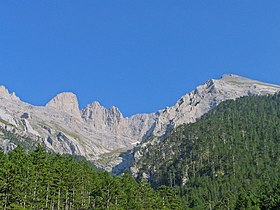Mount Olympus
From Wikipedia, the free encyclopedia
This article is about the mountain range in Greece. For the volcano on the planet Mars, see Olympus Mons. For other uses, see Olympus.
| This article needs additional citations for verification. (March 2016) |
| Mount Olympus | |
|---|---|

Mount Olympus
| |
| Highest point | |
| Elevation | 2,918 m (9,573 ft) [1] |
| Prominence | 2,355 m (7,726 ft) [2] |
| Listing | Country high point Ultra |
| Coordinates | 40°05′08″N 22°21′31″ECoordinates: 40°05′08″N 22°21′31″E |
| Geography | |
| Location | Greece |
| Parent range | Macedonia and Thessaly, near the Gulf of Salonika |
| Climbing | |
| First ascent | 2 August 1913 Christos Kakalos, Frederic Boissonnas and Daniel Baud-Bovy |
| Easiest route | Hike, some rock scramble |
Mount Olympus (/oʊˈlɪmpəs, ə-/;[3] Greek: Όλυμπος; also transliterated as Olympos, and on Greek maps, Oros Olympos) is the highest mountain in Greece and the second highest mountain in the Balkans. It is located in the Olympus Range on the border between Thessaly and Macedonia, between the regional units of Pieria and Larissa, about 80 km (50 mi) southwest fromThessaloniki. Mount Olympus has 52 peaks, deep gorges, and exceptional biodiversity.[4] The highest peak Mytikas, meaning "nose", rises to 2,918 metres (9,573 ft).[5] It is one of the highest peaks in Europe in terms of topographic prominence.[2]
Olympus was notable in Greek mythology as the home of the Twelve Olympians, on the Mytikas peak. Mount Olympus is also noted for its very rich flora with several species. It has been the first National Park of Greece, since 1938, and a World's Biosphere Reserve.[citation needed]
Every year thousands of people visit Olympus to admire its nature, to tour its slopes, and reach its peaks. Organized mountain refuges and various mountaineering and climbing routes are available to visitors, who want to explore its nature. The usual starting point for it is the town of Litochoro, on the eastern foothills of the mountain, 100 km from Thessaloniki, where, in the beginning of every summer, the Olympus Marathon terminates.[6]
Climate[edit]
Generally speaking Olympus' climate can be described as one of mediterranean type with continental influence. Its local variations is the result of the impact of the sea and the rugged relief of the region.
In the lower locations (Litochoro and the foothills) the climate is typically mediterranean, i.e. hot and dry in the summer, while humid and cold in the winter. Higher it is more humid and severe, with more intense phenomena ; in these locations it often snows all over the winter, while raining and snowing is not unusual, even in the summer. The temperature varies in the winter from -10 °C to 10 °C and in the summer from 0 °C to 20 °C, while winds are an almost everyday occurrence. Generally the temperature falls 1 °C per 200 m of altitude. As the altitude rises, the phenomena are more intense and the variations of temperature and humidity are often sudden. The coastal northeast slopes of Olympus receive more rain than the continental northwest, so, as a result, there is a clear difference in vegetation. being more abundant in the first of them. Hottest month is August, while coldest is February.
The mountain's highest zone, over 2,000 metres, is snowcapped for about nine months (September to May). In some places the winds gather snow, 8–10 metres thick, ('anemosouria' in Greek), while in some deep ravines the snow is maintained all over the year (everlasting snow). For this Olympus' alpine region, recordings have been made in the 1960s in the highest-altitude weather station in Greece, that was established on the summit of Aghios Antonios (2,815 m), providing a number of interesting data for the mountain's climate. Τhe average temperature is -5 °C in winter and 10 °C in summer. The average annual precipitation heights vary from 149 cm at Prionia (1,100 m) to 170 cm at Aghios Antonios, about half of them rainfall and hailstorms in summer and the rest snowfall in winter. The weather may change several times in the same day.
In summer rainfalls are frequent, commonly as evening thunderstorms, many times accompanied by hail and strong winds. However water springs over 2,000 metres are scarce and visitors should ensure that they have always water and of course the necessary clothing for any weather conditions.
Olympus' endemic plants[edit]
- Achillea ambrosiaca
- Alyssum handelii
- Asprerula muscosa
- Aubrieta thessala
- Campanula oreadum
- Carum adamovicii
- Centaurea incompleta
- Centaurea litochorea
- Centaurea transiens
- Cerastrium theophrasti
- Erysimum olympicum
- Festuca olympica
- Genίsta sakellariadis
- Jankaea heldreichii
- Ligusticum olympicum
- Melampyrum ciliatum
- Poa thessala
- Potentilla deorum
- Rynchosinapis nivalis
- Silene dionysii
- Silene oligantha
- Veronica thessalica
- Viola striis - notata



Δεν υπάρχουν σχόλια:
Δημοσίευση σχολίου